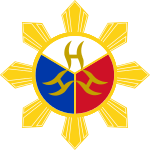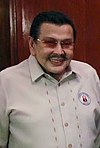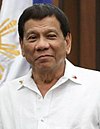National Artist of the Philippines
 From Wikipedia - Reading time: 14 min
From Wikipedia - Reading time: 14 min
| Order of National Artists of the Philippines Orden ng mga Pambansang Alagad ng Sining ng Pilipinas | |
|---|---|
 Emblem of the Order of National Artists, which appears on the collar bestowed on members. | |
| Awarded by | |
| Type | Order |
| Awarded for | Having made significant contributions to the development of Philippine arts |
| Status | Currently constituted |
| Sovereign | President of the Philippines |
| Statistics | |
| First induction | 1972 |
| Last induction | 2022 |
| Precedence | |
| Next (higher) | Order of Gabriela Silang |
| Next (lower) | Gawad Mabini |
| Equivalent | Order of National Scientists, Gawad sa Manlilikha ng Bayan, Order of Lakandula – Special Class of Champion for Life |
Ribbon bar of the Order | |
The Order of National Artists of the Philippines (Tagalog: Orden ng mga Pambansang Alagad ng Sining ng Pilipinas) is an order bestowed by the President of the Philippines on Philippine nationals who have made significant contributions to the development of Philippine art. Members of the order are known as National Artists. Originally instituted as an award, it was elevated to the status of an order in 2003.[1]
The order is administered by the Cultural Center of the Philippines by virtue of President Ferdinand Marcos's Proclamation No. 1001 of April 2, 1972, and the National Commission for Culture and the Arts. The first award was posthumously conferred on Filipino painter Fernando Amorsolo.
Definition
[edit]The order of the highest state honor is conferred on individuals deemed as having done much for their artistic field. Deserving individuals must have been recommended by both the Cultural Center and the National Commission for Culture and the Arts prior to receiving the award. Such people are then titled, by virtue of a Presidential Proclamation, as National Artist (Filipino: Gawad Pambansang Alagad ng Sining), and are inducted into the order.
Categories
[edit]Categories under which National Artists can be recognized originally included:[2]
- Music – singing, composition, direction, and/or performance;
- Dance – choreography, direction and/or performance;
- Theater – direction, performance and/or production design;
- Contemporary Arts – painting, sculpture, printmaking, photography, installation art, mixed media works, illustration, graphic arts, performance art and/or imaging;
- Literature – poetry, fiction, essay, playwriting, journalism and/or literary criticism;
- Film and Broadcasting/Broadcast Arts – direction, writing, production design, cinematography, editing, camera work, and/or performance; and
- Architecture, Design and Allied Arts – architecture design, interior design, industrial arts design, landscape architecture and fashion design.
However, National Artists have since been honored under new categories. The NCCA created the category of National Artist for Fashion Design when it nominated Ramon Valera, but subsumed that category under "Architecture, Design and Allied Arts". President Fidel V. Ramos issued an executive order creating the category of National Artist for Historical Literature before conferring the honor to Carlos Quirino.
Criteria
[edit]
The National Artists of the Philippines is based on broad criteria, as set forth by the Cultural Center of the Philippines and the National Commission on Culture and the Arts:[2]
- Living artists who have been Filipino citizens for the last ten years prior to nomination as well as those who have died after the establishment of the Award in 1972 but were Filipino citizens at the time of their death;
- Artists who have helped build a Filipino sense of nationhood through the content and form of their works;
- Artists who have distinguished themselves by pioneering in a mode of creative expression or style, making an impact on succeeding generations of artists;
- Artists who have created a significant body of works and/or have consistently displayed excellence in the practice of their art form, enriching artistic expression or style; and
- Artists who enjoy broad acceptance through prestigious national and/or international recognition, Award in prestigious national and/or international events, critical acclaim and/or reviews of their works, and/or respect and esteem from peers within an artistic discipline.
Nominations are then submitted to the National Artist Secretariat which is created by the National Artist Award Committee; experts from different art fields then sit on a First Deliberation to prepare the short list of nominees. A Second Deliberation, which is a joint meeting of the Commissioners of the NCCA and the Board of Trustees of the CCP, decides on the final nominees. The list is then forwarded to the President of the Philippines, who, by Presidential Proclamation, proclaims the final nominees as members of the Order of National Artists.[3]
Benefits
[edit]- The rank and title of National Artist, as proclaimed by the President of the Philippines;[4]
- A grand collar of the Order of National Artist and a citation;
- A lifetime emolument and material and physical benefits comparable in value to those received by the highest officers of the land such as:
- a cash Award of one hundred thousand pesos (₱100,000.00) net of taxes, for living awardees;
- a cash Award of seventy-five thousand pesos (₱75,000.00) net of taxes, for posthumous awardees, payable to legal heir/s;
- a monthly life pension, medical and hospitalization benefits;
- life insurance coverage for Awardees who are still insurable;
- a state funeral and burial at the Libingan ng mga Bayani;
- a place of honor, in line with protocolar precedence, at national state functions, and recognition at cultural events.
Roster of National Artists
[edit]^1 In May 2006, under the Arroyo administration, the National Commission on Culture and the Arts (NCCA) already conferred the award to Poe but the late actor's wife, Susan Roces refused to acknowledge it. President Aquino has approved and signed Proclamation 435 affirming the previous proclamation of former President Gloria Macapagal-Arroyo declaring the late movie icon Fernando Poe Jr. a National Artist, posthumously. The Poe family finally accepted the conferment on 16 August 2012. .[7]
^2 Aguilar Alcuaz, Francisco, and Conde were all proclaimed in 2009 but the conferment of the order was delayed due to a controversy. The order was finally bestowed in a ceremony at Malacañang Palace in November 2013.[5]
|
|
Nominations
[edit]Since the establishment in 1972 of the order for artists who have contributed largely in their respective fields, government and non-government cultural organizations and educational institutes have nominated candidates deemed eligible and worthy of such recognition.[8] Unfortunately, the Cultural Center of the Philippines and the National Commission for Culture and the Arts does not reveal their deliberations and list of candidates received.[8]
The following list features noted personalities nominated for their respective fields:[9][10]
|
|
2009 National Artist of the Philippines controversy
[edit]In August 2009, the conferment of the Order of National Artists on seven individuals by President Gloria Macapagal Arroyo[11] became controversial when it was revealed that musician Ramon Santos had been dropped from the list of nominees short-listed in May that year by the selection committee, and that four other individuals had been nominated via "President's prerogative": Cecile Guidote-Alvarez (Theater), Carlo J. Caparas (Visual Arts and Film), Francisco Mañosa (Architecture), and Pitoy Moreno (Fashion Design).[4][12]
Members of the Philippine art community–including a number of living members of the Order–protested that the proclamation politicised the title of National Artist, and made it "a way for President Gloria Macapagal-Arroyo to accommodate her allies." Specific protests were raised regarding the nomination of Guidote-Alvarez, who was also executive director of the National Commission for Culture and the Arts, because it was purportedly a breach of protocol and delicadeza (propriety), and of Caparas, on the grounds that he was unqualified for nomination under both the Visual Arts and the Film categories.[12][13] On July 16, 2013, the controversy finally ended after the Supreme Court of the Philippines voted 12-1-2 that voided the four proclamations.[14]
On June 20, 2014, five years after he was originally shortlisted in 2009, Ramon Santos was finally conferred National Artist for Music by President Benigno S. Aquino III.[6]
See also
[edit]- Art of the Philippines
- Culture of the Philippines
- National Living Treasures Award (Philippines)
- Tourism in the Philippines
References
[edit]- ^ Executive Order No. 236, s. 2003 Official Gazette of the Republic of the Philippines. Retrieved October 24, 2018.
- ^ a b "The National Artists of the Philippines Guidelines". ncca.gov.ph. National Commission for Culture and the Arts. 2007. Archived from the original on August 28, 2009. Retrieved August 20, 2009.
- ^ mlq3. "Proclaimed a National Artist, not awarded » Manuel L. Quezon III". quezon.ph.
{{cite web}}: CS1 maint: numeric names: authors list (link) - ^ a b Annie Ruth C. Sabangan (August 1, 2009). "Fury over Arroyo's choice of national artists". GMANews.tv: The Official Website of GMA News and Public Affairs.
- ^ a b "Aguilar Alcuaz, Francisco, Conde– deceased all–to be finally conferred National Artist awards in November". Retrieved October 20, 2013.
- ^ a b Palace Declares New National Artists. Philippine Daily Inquirer (June 21, 2014)
- ^ "Aquino confers Order of National Artist for Cinema on late Fernando Poe Jr". Retrieved October 20, 2013.
- ^ a b "NCCA opens nominations for persons worthy of being named national artists". ifacca.org. January 5, 2024. Retrieved October 10, 2024.
- ^ Pablo A. Tariman (August 26, 2024). "Cecile Licad, Gilopez Kabayao, Nonoy Froilan, Vilma Santos are nominated for National Artists". verafiles.org.
- ^ 22 March 2012. "NCCA, CCP name early nominees for National Artists Award". Manila Standard.
{{cite web}}: CS1 maint: numeric names: authors list (link) - ^ T. J. Burgonio (July 29, 2009). "Arroyo names 7 National Artists for '09". Philippine Daily Inquirer. Archived from the original on August 1, 2009.
- ^ a b Kristine L. Alave, Bayani San Diego Jr. (August 1, 2009). "Palace choices of 4 nat'l artists protested". Philippine Daily Inquirer. Archived from the original on August 4, 2009.
- ^ Gerry Alanguilan (2009). "Bottom Line: Carlo J. Caparas is NOT Qualified". Komikero Comics Journal. Komikero Comics Journal. Archived from the original on August 2, 2009. Retrieved August 4, 2009.
- ^ Mark Merueñas (July 16, 2013). "SC voids National Artist Award on Carlo Caparas, 3 others". GMA News and Public Affairs.
External links
[edit] Media related to National Artists of the Philippines at Wikimedia Commons
Media related to National Artists of the Philippines at Wikimedia Commons- List of National Artists (NCCA). From the National Commission on Culture and the Arts (NCCA) website.
- National Artists Guidelines (NCCA)
- The Order of National Artists – from the Official Gazette of the Philippines (Office of the President)
- National Artists in Waiting: Six in a Fix
 KSF
KSF





































































